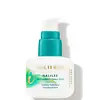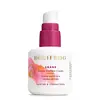What's inside
What's inside
 Key Ingredients
Key Ingredients

 Benefits
Benefits

 Concerns
Concerns

No concerns
 Ingredients Side-by-side
Ingredients Side-by-side

Aloe Barbadensis Leaf Juice
Skin ConditioningSqualane
EmollientGlycerin
HumectantSclerocarya Birrea Seed Oil
HumectantSimmondsia Chinensis Seed Oil
EmollientWater
Skin ConditioningPrunus Armeniaca Kernel Oil
MaskingNiacinamide
SmoothingPanthenol
Skin ConditioningAvena Sativa Bran Extract
AbrasiveUbiquinone
AntioxidantLonicera Japonica Flower Extract
Skin ConditioningLycium Barbarum Fruit Extract
AstringentThioctic Acid
AntioxidantPotassium Azeloyl Diglycinate
Skin ConditioningSuperoxide Dismutase
AntioxidantOryza Sativa Extract
AbsorbentCamellia Sinensis Leaf Extract
AntimicrobialSodium Hyaluronate
HumectantTocopheryl Acetate
AntioxidantLeuconostoc Ferment Filtrate
AntimicrobialSoybean Peroxidase
AntioxidantXanthan Gum
EmulsifyingMaltodextrin
AbsorbentCitrus Aurantium Dulcis Peel Extract
Emulsion StabilisingPhenethyl Alcohol
MaskingEthylhexylglycerin
Skin ConditioningAloe Barbadensis Leaf Juice, Squalane, Glycerin, Sclerocarya Birrea Seed Oil, Simmondsia Chinensis Seed Oil, Water, Prunus Armeniaca Kernel Oil, Niacinamide, Panthenol, Avena Sativa Bran Extract, Ubiquinone, Lonicera Japonica Flower Extract, Lycium Barbarum Fruit Extract, Thioctic Acid, Potassium Azeloyl Diglycinate, Superoxide Dismutase, Oryza Sativa Extract, Camellia Sinensis Leaf Extract, Sodium Hyaluronate, Tocopheryl Acetate, Leuconostoc Ferment Filtrate, Soybean Peroxidase, Xanthan Gum, Maltodextrin, Citrus Aurantium Dulcis Peel Extract, Phenethyl Alcohol, Ethylhexylglycerin
Water
Skin ConditioningAloe Barbadensis Leaf Juice
Skin ConditioningGlycerin
HumectantIsoamyl Laurate
EmollientHelianthus Annuus Seed Oil
EmollientCetearyl Olivate
Sorbitan Olivate
EmulsifyingNiacinamide
SmoothingOryza Sativa Bran Oil
EmollientSimmondsia Chinensis Seed Oil
EmollientVaccinium Macrocarpon Seed Oil
Skin ConditioningCannabis Sativa Seed Oil
EmollientSea Water
HumectantPalmitoyl Tripeptide-5
Skin ConditioningPalmitoyl Tripeptide-38
Skin ConditioningTetrahexyldecyl Ascorbate
AntioxidantCeramide NP
Skin ConditioningArginine
MaskingGlycine
BufferingAlanine
MaskingSodium PCA
HumectantSerine
MaskingValine
MaskingIsoleucine
Skin ConditioningProline
Skin ConditioningThreonine
Phenylalanine
MaskingHistidine
HumectantPCA
HumectantSqualane
EmollientHippophae Rhamnoides Seed Oil
Skin ProtectingCarthamus Tinctorius Seed Oil
MaskingMorus Alba Leaf Extract
Skin ConditioningHydrolyzed Rhodophyceae Extract
Althaea Officinalis Root Extract
Skin ConditioningChlorella Vulgaris Extract
Skin ConditioningCitrullus Lanatus Fruit Extract
Skin ConditioningLens Esculenta Fruit Extract
Skin ConditioningPyrus Malus Fruit Extract
Skin ConditioningTocopherol
AntioxidantSea Salt
AbrasiveSqualene
EmollientOlive Oil Decyl Esters
Aspartic Acid
MaskingMaltodextrin
AbsorbentSodium Lactate
BufferingHydrated Silica
AbrasivePropanediol
SolventBentonite
AbsorbentXanthan Gum
EmulsifyingIsocetyl Alcohol
EmollientCetyl Alcohol
EmollientLactic Acid
BufferingCitric Acid
BufferingIsoamyl Cocoate
Pullulan
Hydroxypropyl Cyclodextrin
MaskingDehydroacetic Acid
PreservativeSodium Benzoate
MaskingPotassium Sorbate
PreservativeBenzyl Alcohol
PerfumingWater, Aloe Barbadensis Leaf Juice, Glycerin, Isoamyl Laurate, Helianthus Annuus Seed Oil, Cetearyl Olivate, Sorbitan Olivate, Niacinamide, Oryza Sativa Bran Oil, Simmondsia Chinensis Seed Oil, Vaccinium Macrocarpon Seed Oil, Cannabis Sativa Seed Oil, Sea Water, Palmitoyl Tripeptide-5, Palmitoyl Tripeptide-38, Tetrahexyldecyl Ascorbate, Ceramide NP, Arginine, Glycine, Alanine, Sodium PCA, Serine, Valine, Isoleucine, Proline, Threonine, Phenylalanine, Histidine, PCA, Squalane, Hippophae Rhamnoides Seed Oil, Carthamus Tinctorius Seed Oil, Morus Alba Leaf Extract, Hydrolyzed Rhodophyceae Extract, Althaea Officinalis Root Extract, Chlorella Vulgaris Extract, Citrullus Lanatus Fruit Extract, Lens Esculenta Fruit Extract, Pyrus Malus Fruit Extract, Tocopherol, Sea Salt, Squalene, Olive Oil Decyl Esters, Aspartic Acid, Maltodextrin, Sodium Lactate, Hydrated Silica, Propanediol, Bentonite, Xanthan Gum, Isocetyl Alcohol, Cetyl Alcohol, Lactic Acid, Citric Acid, Isoamyl Cocoate, Pullulan, Hydroxypropyl Cyclodextrin, Dehydroacetic Acid, Sodium Benzoate, Potassium Sorbate, Benzyl Alcohol
 Reviews
Reviews

Ingredients Explained
These ingredients are found in both products.
Ingredients higher up in an ingredient list are typically present in a larger amount.
Aloe Barbadensis Leaf Juice comes from leaves of the aloe plant. Aloe Barbadensis Leaf Juice is best known for helping to soothe sunburns. It is also anti-inflammatory, moisturizing, antiseptic, and can help heal wounds.
Aloe is packed with good stuff including Vitamins A, C, and E. These vitamins are antioxidants, which help fight free-radicals and the damage they may cause. Free-radicals are molecules that may damage your skin cells, such as pollution.
Aloe Barbadensis Leaf Juice also contains sugars. These sugars come in the form of monosaccharides and polysaccharides, folic acid, and choline. These sugars are able to help bind moisture to skin.
It also contains minerals such as calcium, 12 anthraquinones, fatty acids, amino acids, and Vitamin B12.
Learn more about Aloe Barbadensis Leaf JuiceGlycerin is already naturally found in your skin. It helps moisturize and protect your skin.
A study from 2016 found glycerin to be more effective as a humectant than AHAs and hyaluronic acid.
As a humectant, it helps the skin stay hydrated by pulling moisture to your skin. The low molecular weight of glycerin allows it to pull moisture into the deeper layers of your skin.
Hydrated skin improves your skin barrier; Your skin barrier helps protect against irritants and bacteria.
Glycerin has also been found to have antimicrobial and antiviral properties. Due to these properties, glycerin is often used in wound and burn treatments.
In cosmetics, glycerin is usually derived from plants such as soybean or palm. However, it can also be sourced from animals, such as tallow or animal fat.
This ingredient is organic, colorless, odorless, and non-toxic.
Glycerin is the name for this ingredient in American English. British English uses Glycerol/Glycerine.
Learn more about GlycerinMaltodextrin is a polysaccharide. It is derived from starch such as rice, corn, wheat, or potato starch.
In food, Maltodextrin is used to improve the texture and thicken a product. Due to its structure, it can help create a gel texture. As an emulsion stabilizer, it helps keep the ingredients in a product together.
As a polysaccharide, Maltodextrin has moisturizing properties. Polysaccharides are a type of carbohydrate. The top layer of skin uses polysaccharides to retain water, keeping the skin hydrated.
Maltodextrin is water soluble and has a sweet taste.
Learn more about MaltodextrinNiacinamide is a multitasking form of vitamin B3 that strengthens the skin barrier, reduces pores and dark spots, regulates oil, and improves signs of aging.
And the best part? It's gentle and well-tolerated by most skin types, including sensitive and reactive skin.
You might have heard of "niacin flush", or the reddening of skin that causes itchiness. Niacinamide has not been found to cause this.
In very rare cases, some individuals may not be able to tolerate niacinamide at all or experience an allergic reaction to it.
If you are experiencing flaking, irritation, and dryness with this ingredient, be sure to double check all your products as this ingredient can be found in all categories of skincare.
When incorporating niacinamide into your routine, look out for concentration amounts. Typically, 5% niacinamide provides benefits such as fading dark spots. However, if you have sensitive skin, it is better to begin with a smaller concentration.
When you apply niacinamide to your skin, your body converts it into nicotinamide adenine dinucleotide (NAD). NAD is an essential coenzyme that is already found in your cells as "fuel" and powers countless biological processes.
In your skin, NAD helps repair cell damage, produce new healthy cells, support collagen production, strengthen the skin barrier, and fight environmental stressors (like UV and pollution).
Our natural NAD levels start to decline with age, leading to slower skin repair, visible aging, and a weaker skin barrier. By providing your skin niacinamide, you're recharging your skin's NAD levels. This leads to stronger, healthier, and younger looking skin.
Another name for vitamin B3 is nicotinamide. This vitamin is water-soluble and our bodies don't store it. We obtain Vitamin B3 from either food or skincare. Meat, fish, wheat, yeast, and leafy greens contain vitamin B3.
The type of niacinamide used in skincare is synthetically created.
Learn more about NiacinamideThis oil comes from the seeds of the desert shrub called Jojoba. It is more commonly known as jojoba oil, a non-comedogenic oil.
Jojoba oil does not contain fragrance and has many fatty-acids, making it a great soothing ingredient.
It also contains Vitamin E, a great moisturizing ingredient. Vitamin E is also an antioxidant and protects your skin against oxidative damage.
This ingredient humectant properties, meaning it helps draw moisture from the air. This helps keep your skin hydrated.
While jojoba has antibacterial properties, it is only able to kill some strains of bacteria.
Studies also show it helps in wound healing. In fact, Indigenous cultures have used jojoba as a moisturizer and to help treat burns for centuries.
Fun fact: Jojoba oil similar to natural human skin sebum, so it has a great effect on dry skin. It is also promising with helping to regulate sebum production.
Due to its fatty acid content, Jojoba oil may not be fungal acne safe. We recommend speaking with a professional if you have any concerns.
Learn more about Simmondsia Chinensis Seed OilSqualane is an emollient that helps the skin hold onto moisture. It's an oily liquid that occurs naturally in certain types of fish and plant oils.
Because squalane boosts hydration in the skin, it also comes with plenty of benefits: it is an antioxidant and can help fight free radicals and skin damage. Squalane is also found to have a detoxifying effect when applied.
Squalane comes from squalene, which occurs naturally within the sebum of our skin. It is one of the oils our skin produces to keep itself hydrated. Squalane is the hydrogenated version of squalene and has a longer shelf life.
Research shows that squalane is non-irritating (even at 100% concentration).
In general, it's a fantastic ingredient. It does a great job at hydrating the skin, and it's suitable for those with sensitive skin.
The source of squalane may impact malassezia / fungal acne. This is because olive oil derived squalane can contain impurities such as fatty acids and plant waxes. Sugarcane derived squalane is recommended for anyone with malassezia concerns.
Is squalane vegan?
This depends on the source. Squalane can be derived from both plants and animals. Most squalane used in skincare comes from plants.
Please note: the source of squalane is only known if disclosed by the brand. We recommend reaching out to the brand if you have any questions about their squalane.
Read more about squalene with an "e".
Is squalane an oil?
Squalane is often called an oil, but it’s technically not; it’s a hydrocarbon, meaning it’s only made of carbon and hydrogen, unlike true oils which are triglycerides made of fatty acids and glycerol.
The term “oil-free” isn’t regulated, so companies can define it however they want. Some exclude all oils, while others just avoid mineral oil or comedogenic oils.
While some people avoid oils thinking they cause breakouts, the right kind of oil (or oil-like ingredient like squalane) can actually help balance and hydrate your skin. It’s worth testing out simple oils or squalane to see what works best for your skin.
Learn more about SqualaneWater. It's the most common cosmetic ingredient of all. You'll usually see it at the top of ingredient lists, meaning that it makes up the largest part of the product.
So why is it so popular? Water most often acts as a solvent - this means that it helps dissolve other ingredients into the formulation.
You'll also recognize water as that liquid we all need to stay alive. If you see this, drink a glass of water. Stay hydrated!
Learn more about WaterXanthan gum is used as a stabilizer and thickener within cosmetic products. It helps give products a sticky, thick feeling - preventing them from being too runny.
On the technical side of things, xanthan gum is a polysaccharide - a combination consisting of multiple sugar molecules bonded together.
Xanthan gum is a pretty common and great ingredient. It is a natural, non-toxic, non-irritating ingredient that is also commonly used in food products.
Learn more about Xanthan Gum